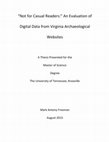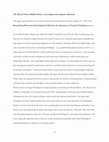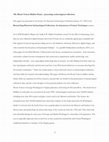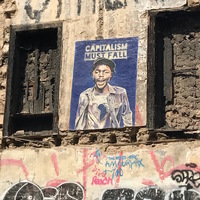Papers by Mark Freeman

Archaeological data dissemination is complicated by the need to serve disparate audiences,
each ... more Archaeological data dissemination is complicated by the need to serve disparate audiences,
each of which has different data needs. This study examined the websites of 148 Virginia institutions
identified as having archaeological collections or data, and used content analysis to see how they
supported characteristics of scholarly publishing, open data and public outreach. Archaeologists are
increasingly looking for comparative data sets for research needs, with professional ethics and a desire
for public engagement encouraging data sharing. However this analysis suggests that, while there are
some exemplary websites, much of the archaeological record remains publicly inaccessible. The majority
of websites examined provided no reference to archaeology and, of the remainder, a third did not
provide archaeological data. These websites did provide many supporting characteristics for public
outreach, but concerns about preservation, data “openness,” and limited datasets remain.

In its 2008 President's Report the Andrew W. Mellon Foundation noted "In the field of archaeology... more In its 2008 President's Report the Andrew W. Mellon Foundation noted "In the field of archaeology, most data are now collected in digital formats, but in the US there are no commonly agreed upon standards and little capacity for preserving and providing access to the databases, electronic field notes, digital images, and other materials that document archaeological findings". As a parallel finding Kansa and Kansa (2011), in a white paper for the NEH Division of Preservation and Access, examined how researchers -from museums, universities, cultural resource management and conservation organizations, public archaeology, and independent scholars -were using digital archaeology data in research. An early finding from their study was that "participants uniformly said that they used few, if any Web-based collections or resources developed by the research community." These two studies point to issues with both access to archaeological collections, and their utility for research and understanding. This paper will discuss the Mount Vernon midden website which, while not a panacea for all the concerns, may provide one model for the presentation of archaeological collections data; and also some thoughts on the potential audience for such collections.
A Web survey was placed on the National Park Service web catalog website in October 2013 to inves... more A Web survey was placed on the National Park Service web catalog website in October 2013 to investigate user segmentation. The survey ran for a month, gathering 39 responses. Segmentation categories followed earlier studies, with the addition of a further sub-division by category for researchers. The results show that educators are not using the site, though it was not possible to see if it was being used by K-12 students. Historians were the majority of the research users of the site. The study is part of a larger analysis of website visitation, and will provide a guide for website changes and benchmark data for future studies.
Conference Presentations by Mark Freeman

Middle Atlantic Archaeological Conference (MAAC) 2012 paper.
An important component of the “Engag... more Middle Atlantic Archaeological Conference (MAAC) 2012 paper.
An important component of the “Engaging the Piedmont: Transitions in Virginia Slavery 1730-1790” project is public outreach. The project website seeks to inform both a professional and wider audience through papers, images, blogs and specific content aimed at K-12 and teachers. This paper discusses the first educational interactive module, aimed at grades 10-12. It allows students to look at land patterns through an exhaustive study of patents. Students engage with maps, and related primary documents, showing changing land ownership from 1710 through 1770. They are asked to consider how rivers and roads affected development, and to consider the effect of land fragmentation and family ownership on the building of community, for both the land owners and their enslaved workers.
Available at http://web.utk.edu/~bheath2/education.html

In its 2008 President's Report the Andrew W. Mellon Foundation noted "In the field of archaeology... more In its 2008 President's Report the Andrew W. Mellon Foundation noted "In the field of archaeology, most data are now collected in digital formats, but in the US there are no commonly agreed upon standards and little capacity for preserving and providing access to the databases, electronic field notes, digital images, and other materials that document archaeological findings". As a parallel finding Kansa and Kansa (2011), in a white paper for the NEH Division of Preservation and Access, examined how researchers -from museums, universities, cultural resource management and conservation organizations, public archaeology, and independent scholars -were using digital archaeology data in research. An early finding from their study was that "participants uniformly said that they used few, if any Web-based collections or resources developed by the research community." These two studies point to issues with both access to archaeological collections, and their utility for research and understanding. This paper will discuss the Mount Vernon midden website which, while not a panacea for all the concerns, may provide one model for the presentation of archaeological collections data; and also some thoughts on the potential audience for such collections.
Digital Projects by Mark Freeman
Website showcasing the collections of the National Park Service
This website was created to present artifacts excavated by archaeologists from the eighteenth-cen... more This website was created to present artifacts excavated by archaeologists from the eighteenth-century South Grove Midden (or refuse feature) located at Mount Vernon, George Washington’s Virginia plantation on the Potomac River. The heart of this website is a searchable database of objects – complete with photographs, detailed summaries, and catalog information – connected to a rich body of documentary and thematic material.
This site focuses on comparing evidence from excavated houses and yards that are associated with ... more This site focuses on comparing evidence from excavated houses and yards that are associated with a single enslaved community who, between 1730 and 1780, lived at three separate sites in the piedmont: Indian Camp in modern-day Powhatan County, and the Wingo's and North Hill quarters on the Poplar Forest plantation in Bedford County.
The website includes reports, images and 4 educational modules.











Uploads
Papers by Mark Freeman
each of which has different data needs. This study examined the websites of 148 Virginia institutions
identified as having archaeological collections or data, and used content analysis to see how they
supported characteristics of scholarly publishing, open data and public outreach. Archaeologists are
increasingly looking for comparative data sets for research needs, with professional ethics and a desire
for public engagement encouraging data sharing. However this analysis suggests that, while there are
some exemplary websites, much of the archaeological record remains publicly inaccessible. The majority
of websites examined provided no reference to archaeology and, of the remainder, a third did not
provide archaeological data. These websites did provide many supporting characteristics for public
outreach, but concerns about preservation, data “openness,” and limited datasets remain.
Conference Presentations by Mark Freeman
An important component of the “Engaging the Piedmont: Transitions in Virginia Slavery 1730-1790” project is public outreach. The project website seeks to inform both a professional and wider audience through papers, images, blogs and specific content aimed at K-12 and teachers. This paper discusses the first educational interactive module, aimed at grades 10-12. It allows students to look at land patterns through an exhaustive study of patents. Students engage with maps, and related primary documents, showing changing land ownership from 1710 through 1770. They are asked to consider how rivers and roads affected development, and to consider the effect of land fragmentation and family ownership on the building of community, for both the land owners and their enslaved workers.
Available at http://web.utk.edu/~bheath2/education.html
Digital Projects by Mark Freeman
The website includes reports, images and 4 educational modules.
each of which has different data needs. This study examined the websites of 148 Virginia institutions
identified as having archaeological collections or data, and used content analysis to see how they
supported characteristics of scholarly publishing, open data and public outreach. Archaeologists are
increasingly looking for comparative data sets for research needs, with professional ethics and a desire
for public engagement encouraging data sharing. However this analysis suggests that, while there are
some exemplary websites, much of the archaeological record remains publicly inaccessible. The majority
of websites examined provided no reference to archaeology and, of the remainder, a third did not
provide archaeological data. These websites did provide many supporting characteristics for public
outreach, but concerns about preservation, data “openness,” and limited datasets remain.
An important component of the “Engaging the Piedmont: Transitions in Virginia Slavery 1730-1790” project is public outreach. The project website seeks to inform both a professional and wider audience through papers, images, blogs and specific content aimed at K-12 and teachers. This paper discusses the first educational interactive module, aimed at grades 10-12. It allows students to look at land patterns through an exhaustive study of patents. Students engage with maps, and related primary documents, showing changing land ownership from 1710 through 1770. They are asked to consider how rivers and roads affected development, and to consider the effect of land fragmentation and family ownership on the building of community, for both the land owners and their enslaved workers.
Available at http://web.utk.edu/~bheath2/education.html
The website includes reports, images and 4 educational modules.